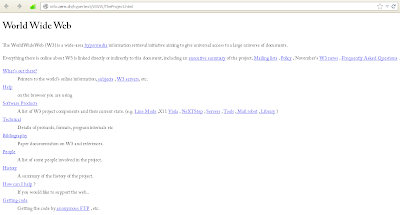British physicist Tim Berners-Lee invented the world wide web, also called W3 or just the web, in 1989 to help physicists to share information.At the time it was just one of several such information retrieval systems using the internet.
On April 30, 1993, the European Organization for Nuclear Research (CERN), where Sir Tim worked, made the web available to the world for free.
The technology was launched with the world's first website, which explained how the web worked.
The site, hosted on Sir Tim's NeXT computer, allowed early browsers to learn about the basic features of the new system and create their own web pages.
You can Also Take A look at World's First Website here as in This Pic : The World's First Website!!
"It's one of the biggest days in the history of the web," CERN web manager Luke Noyes said of the historic day 20 years ago."CERN's gesture of giving away the web for free was what made it just explode."The site, which described the web as a "wide-area hypermedia information retrieval initiative", has long been dormant but CERN has now begun recreating the page.
Mr Noyes says the project will allow future generations to understand the origin and importance of the web and its impact on modern life"We're going to put these things back in place, so that a web developer or someone who's interested 100 years from now can read the first documentation that came out from the world wide web team," he said.
'Missing disk'
The CERN team has restored the files using a 1992 copy of the first website, but hopes to find earlier copies."We know there is a missing disk that has a 1990 copy of the first website somewhere,"
Mr Noyes said, stressing that the restoration project is open and urging the public to get involved."Someone out there might know where [the disk] is, and we would really like some help and collaboration in tracking these things down," he said.Mr Noyes says the first browser was "actually very sophisticated, with images and features that don't really exist anymore, like being able to edit web pages as well as read them".
"We would like to somehow enable people to try this," he said.But he says it remains unclear how that will be accomplished.He says the CERN team is considering creating some kind of emulator, or possibly filming the process to show what it looked like.Mr Noyes says by making the birth of the web visible again, the CERN team aims to emphasise the idea of freedom and openness it was built on."
In the early days, you could just go in and take the code and make it your own and improve it. That is something we have all benefitted from," he said.He says while CERN is not promoting any specific ideology, "we want to preserve that idea of openness and freedom to collect and collaborate".Mr Noyes says other information sharing systems that had wanted to charge royalties, like the University of Minnesota's Gopher, "just sort of disappeared into history".
Berners-Lee�s early WWW work was done on a NeXT Computer (created by Steve Jobs, after he left Apple in the �80s as You can see in Image..
Berners-Lee developed a simple text-based browser called WorldWideWeb in 1990 to accompany the project, but it wasn�t until the release of Mosaic by the National Center for Supercomputing Applications (NCSA) in 1993, following the open-sourcing of the WWW technologies, that the web really began to grow in earnest. Mosaic was a free-for-non-commercial-use graphical browser developed by Marc Andreessen and Eric Bina, with funding from Al Gore�s High Performance Computing and Communication Act of 1991 (yes, this is the basis of the Al Gore invented the internet story.) After graduating from university Andreessen went on to form the Mosaic Communications Corporation, in 1994 Mosaic changed its name to Netscape, in 1997 the first Browser War was sparked by Microsoft�s release of Internet Explorer 4 � and the rest, as they say, is history.
As for Tim Berners-Lee, he went on to found the World Wide Web Consortium (W3C) at MIT, with support from DARPA, after leaving CERN in 1994. From there, he continues to guide the development of standardized, open web technologies, and thus the future of the web. The W3C�s primary goal is to ensure the continued compatibility of dozens of browsers, used by billions of surfers, accessing millions of web servers � and so far, despite a few spats involving WebGL and HTML5 DRM extensions, the Consortium seems to be doing rather well.
I hope You guys got at least some Info about World's First Website..

No comments:
Post a Comment